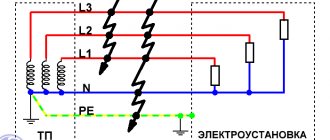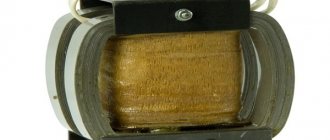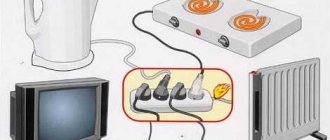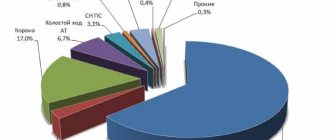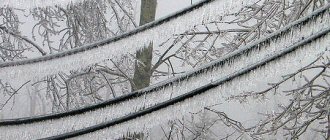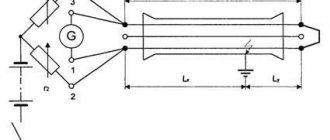Many domestic networks used for electricity transmission have been in operation for a long time. Middle-class power lines, whose power is in the range of 6-35 kV, are subject to especially severe wear. Therefore, they have a fairly high accident rate. Icing and other factors lead to short circuits and other negative consequences. Emergency locations are in most cases determined visually, taking a lot of time and causing power outages. A short circuit indicator (SCI) helps to solve this problem, quickly establishing the fact of a break and accurately indicating the location of the accident.
Short circuit indicators: how to look for damage to overhead lines in Russia
An increase in the number of weather anomalies and limited funding are forcing us to expand the use of modern equipment. Let's look at popular devices available in Russia: short circuit indicators (SCI) for overhead power lines.
Devices for indicating overhead line damage may have different designs, but they all perform one main task - saving money and time, as we talked about earlier. In the event of an accident on the line, it is necessary to carry out a detour with a visual inspection of the wires, usually in conditions of bad roads and precipitation. Short circuit indicators (SCIs) make this job easier. The Russian market includes IKZ from leading international companies, as well as domestic manufacturers. Each brand has its own characteristics that may be useful in different conditions.
How do IKZ save money?
Electricity consumption by the population has increased significantly in recent years. Many household electrical appliances used by the population, as well as equipment from factories and enterprises, force the energy grid to work at its limit. In such conditions, accidents in the power supply system are inevitable, given its condition.
As already mentioned, the location of a power line break or short circuit in our country is determined by the old-fashioned method. The operational field team travels and inspects the line until it finds the problem area. Taking into account that our country is very spacious, the distance between settlements often reaches several tens of kilometers. Therefore, simply driving around such a high-voltage line would take many hours. And considering that accidents on the line do not happen in good weather, moving along our off-road conditions will take even more time.
In addition, prolonged undersupply of electricity to consumers leads to losses. The number of complaints in such conditions increases, which can lead to the imposition of fines on the energy supply organization.
The use of short circuit indicators in the energy sector can significantly reduce the cost of paying for the working time of field service technicians, depreciation of vehicles, and the cost of fuels and lubricants for equipment. When using IKZ in a distribution network system, troubleshooting is reduced to a direct team visit to the accident site and restoration of the integrity of the line.
Modern IKZ technologies are capable of immediately transmitting to the dispatcher’s console information not only about the damage, but also about its location. It has been statistically determined that the use of short circuit indicators reduces the troubleshooting time by more than half, and in some areas by three times. The payback period for such equipment does not exceed two and a half years, provided that equipment is purchased from reliable, trusted companies.
Some brands on the Russian market
The German company Horstmann GmbH is one of the leaders in the development of complex systems for indicating faults in overhead lines. The brand produces all major types of ICP for different amperages, including visual indicators mounted on wires, as well as remote monitoring systems.
"ANTRAX" . This is a Russian full-cycle research and production company with more than 20 years of experience. The largest domestic supplier of IKZ. The company has a patented technology for detecting power line faults. "Antraks" produces all main types of IKZ, which, among other things, are sold abroad.
Amast Power Lines is a Russian engineering company whose product line includes modern ICP. The company has a large market share due to the provision of turnkey solutions.
The Russian one occupies a significant share of the domestic IKZ market and is one of the oldest players. The company produces modern indicators that can be integrated into geographic information systems for managing energy networks.
The Norwegian company Nortroll is one of the oldest European manufacturers of energy equipment. Nortroll has a line of IKZs - these are modern programmable devices with advanced functionality.
The ASTRON design bureau is known in Russia for the development of thermal imagers for military and civilian use. Also in 2008, the company developed its first proprietary IKZ, adapted for Russian overhead power lines.
Which short circuit indicators should I buy?
The German company Horstmann GmbH occupies a special place in the market of special equipment for medium-power electrical networks. Founded in 1946, it has accumulated a wealth of experience in this field. Traditional German quality and the development of the world's best specialists have brought Horstmann products to the forefront among devices of this kind.
Let's look at the range of IKZ produced by Horstman:
| IKZ series | Sensitivity threshold, A | Response time, ms | Operating temperature, °C | Nutrition | Installation location |
| Alpha | 400, 600, 800, 1000 | 100 | -30, +70 | From the network | In switchgear cells |
| Sigma | 100, 200, 300, 400, 600, 800, 1000 (to ground – 20, 40, 60, 80, 100, 120, 160) | 40 – 80 (to ground – 80 – 160) | -30, +70 | From system / Battery | In switchgear cells |
| OPTO-F 3.0 | 400, 600, 800, 1000 | 40, 60, 80, 100, 200, 300, 500 / adjustable | -30, +70 | From system / Battery | In switchgear cells |
| Fluid System | 400, 600, 1000 | 200 | -40, +85 | _ | For high voltage cable |
| Rotor System | 150, 200, 300 | 100 | -40, +85 | _ | For high voltage cable |
| Navigator | Auto setting ≥200 | 100 | -40, +85 | _ | To overhead line wire |
Basic IKZ for installation on wires
The most affordable and easy to install indicators that can be seen during a power line inspection. They are a small device that is attached to a wire or other line element and reports a short circuit using a color or light signal.
The list of solutions from Horstmann includes the simplest ICPs that can be mounted on wires and busbars. The rotary IKZ is equipped with a spring, which, when a short circuit current flows, moves the indicator flag, painted on one side in a bright color. Operation threshold from 150 A.
Horstmann Rotor System in short circuit position
The advantage of such an IKZ is reliability, but after operation it must be manually cocked again. Liquid IKZ does not have this drawback, since the indicator is colored under the influence of the short-circuit magnetic field and becomes transparent again a few hours after the problem is eliminated.
Horstmann Fluid System in standby (left) and trigger position
We have a line of IKZs that are mounted on wires, as well as a small family of devices for mounting on power line supports. Unlike liquid and rotary IKZ from Horstmann, the simplest IKZ-B31 from Antraks is equipped with LEDs, which in the daytime are visible from a distance of up to 100 m with the naked eye (without binoculars). At the same time, different LED blinking algorithms make it possible to determine the type of power line damage from afar. Power is supplied by a lithium battery with a 10-year standby life.
IKZ-V31 for networks 6-35 kV
The IKZ-V31 has a lower response threshold than the rotary and liquid Horstmann IKZs, but the design of the latter is much simpler, and therefore potentially more reliable and durable.
IKZ "Antraks" for poles has a simpler mounting design and a set of reflective flags, which are clearly visible at night in the light of a lantern.
IKZ "Antraks" for pole mounting
The simplest IKZ from this line, IKZ-V1, has a mechanical indication and a reliable design with capacitive power supply from the mains. It does not have a battery or any wireless communication devices.
Nortroll's simplest solution is the Line Troll 110Eμ indicator, which can detect phase-to-phase short circuits and single-phase ground faults.
Line Troll 110Eμ for networks 6—69 kV
A special feature of the indicator is the presence of microswitches that allow you to program response parameters. The IKZ can detect intermittent short circuits, reporting this by flashing a green indicator for 24 hours.
The IKZ returns to standby mode automatically: according to time or after normal supply of current to the network. The lifespan of a lithium battery is 9-10 years.
Line Troll 110Eμ can be used on lines with a grounded neutral. It is not suitable for multi-feed lines and ring lines.
IKZ for overhead lines with two-way power supply
For lines with two-way power supply, you will need models with a direction function - Smart Navigator HV DFCI.
Specifications
They are installed on overhead lines with voltages up to 220 kV. At the same time, they can be used both independently as local fault detection points, and in conjunction with Smart Reporter.
The direction of the short-circuit current passed is recorded by red or green LEDs.
Each indicator on the body has two sides - A and B.
When current flows in the direction from A to B, the red lights will light up, and from B to A, the green lights will light up.
To detect damage, you need to find the two closest triggered ICPs with different color indications - one red, the other green.
With two-way power supply, the short circuit will be located between these points.
Advanced IKZ with the ability to connect to monitoring networks
Horstmann's most advanced ICDs for wires are the Navigator line of indicators. This indicator signals a malfunction using LEDs that are clearly visible from afar, especially at night.
Horstmann Navigator-LM (A) for overhead lines
Like other IKZ, Navigator can be attached to a wire using a special rod without disconnecting the voltage. At the same time, the IKZ mount is reliable enough to withstand winds of up to 200 km/h. A distinctive feature of the indicators is the ability to be used on lines up to 220 kV (Smart Navigator 2.0 HV).
The indicator can store line load data for the last 72 hours, which reduces the risk of false alarms in networks where there are large load fluctuations. Automatic alarm reset can be configured over a wide range from 4 hours to a week. Navigator indicators with the prefix Smart in the name can be part of a remote monitoring system with data transmission via GSM networks.
IKZ "Antraks" for mounting on a wire
IKZ with index “L” can be used for remote detection of short circuits. For example, the IKZ-V34L indicator can communicate with the field team terminal via a direct Bluetooth channel at a short distance or with a remote power system control center via GSM.
The ASTRON design bureau offers the ASTRON-8080 UHL1 indicator for 6-35 kV lines. It detects phase-to-phase short circuits by measuring electromagnetic induction during current surges in the damaged phases.
ASTRON-8080 UHL1
A special feature of the indicator is its ability to register low currents from 4 A, which is important in Russian networks. The IKZ has a very durable polycarbonate body that is UV resistant. ASTRON-8080 is equipped with bright LEDs for indication, as well as GPS and GSM modules. The latter allow indicators to be integrated into an extensive monitoring network. If triggered, the operator immediately receives an SMS with the coordinates of the event. Data can also be sent to the network control center computer. The battery life is 7 years in standby mode, the total service life of the device is 15 years.
The Nortroll product line includes the LineTroll r400D indicator for mounting on a power line pole with a voltage of 6-69 kV. It is capable of detecting single-phase earth faults in the range of 0.5-60 A. The low trip threshold is often especially useful in Russian conditions. The indicator is also capable of detecting a phase-to-phase short circuit of 50-1000 A. The LED indication can display stable and unstable line faults, and special lenses can direct the light in the desired direction. Battery life is 8 years in standby mode.
LineTroll r400D
LineTroll r400D is a smart device with GPS and GSM modules, as well as the ability to tune in at close range via a 2.4 GHz radio channel. The IKZ has a fault counter, can be connected remotely to the control panel, and can be configured via SMS from a mobile phone.
Short circuit tester (SCT)
The short circuit tester IKZ checks the contact network (CS) for the presence of a short circuit (SC), and, if a short circuit is detected, prohibits reclosure. The IKZ is connected to the feeder machine from the side of the contact network, i.e. to the feeder k.s.
The IKZ consists of two parts: high-voltage and low-voltage, Fig. 2. In the high-voltage part there is a test transformer T1, a measuring transformer T2 and two diode strings. The upper diode chain is compensation, the lower one is test. The diodes are shunted with RC circuits to equalize the reverse voltage and limit the rate of rise of the reverse voltage. The diode chains are connected to the secondary winding of the test transformer, the test chain to the 100V tap, the compensation chain to the 200V tap. A supply voltage of 220V is supplied to the primary winding of the test transformer. 360 Ohm resistors are connected in series with the diode chains. The primary winding of the instrument transformer is included in the test circuit. The secondary winding of the measuring transformer is loaded onto a tuning resistor, the voltage from which is supplied to the isolation transformer T3. The tuning resistor sets the ICD response setting. The voltage from the secondary winding of the isolation transformer is rectified and supplied to the threshold element. The winding of the IKZ alarm relay (RSI) is connected to the inverse output of the threshold element. The direct output of the threshold element is connected to the automatic reclosure circuit.
When the feeder circuit breaker is turned on, 3.3 kV is supplied to the contact network and the IKZ, both diode chains are closed, and no current flows through them.
When the feeder circuit breaker is turned off, the voltage in the contact network begins to drop. It is believed that if there is no short circuit in the contact network, then within 2-3 seconds the voltage drops no lower than 250-300 V, and the diode chains remain closed. With a further decrease in voltage in the contact network, the diode chains open and currents I1 and I2 flow through them. The magnitude of the currents is determined by the residual resistance of the contact network Rrest. In the presence of a short circuit, the voltage in the contact network drops immediately to zero.
As the current in the primary winding of the measuring transformer increases, the current in the secondary winding increases and the voltage drop across the tuning resistor increases. Accordingly, the voltage removed from the tuning resistor and supplied to the primary winding of the isolation transformer increases. When the voltage on the secondary winding of the isolation transformer increases above the set point, the threshold element is triggered. A logical 1 signal appears at the direct output X1, a logical 0 signal appears at the inverse output X2. The signal from output X1 enters the AR logic circuit and prohibits the AR. The signal from output X2 is supplied to the coil of the RSI relay. The second terminal of the winding is connected to the power bus –Uk. A potential difference appears at the terminals of the RSI winding and the relay is activated, signaling the presence of a short circuit. The setting is set so that a ban on automatic reclosure is issued when the residual resistance of the contact network is less than 50 Ohms. If the residual resistance is more than 100 Ohms, no prohibition is issued.
The compensation chain serves to improve the selectivity of the IKZ operation.
Rice. 1. Functional diagram of automatic reclosure of the feeder
Rice. 2. Short circuit tester circuit
Literature
1. Pochaevets V. S. Automated control systems for power supply devices of railways. M.: Route, 2003. – 318 p.
2. Vasilevsky N. N. et al. Automation and telemechanics equipment in power supply devices. M.: Transport, 1971. – 256 p.
3. Pochaevets V. S. Protection and automation of power supply devices. M.: State Educational Institution “Training and Methodological Center for Education in Railway Transport”, 2007. – 191 p.
Educational edition
Frolov Leonid Alexandrovich
Comprehensive solutions for monitoring ICH
There is only one IKZ - LED overhead line damage indicator (IPL). This device has a number of features: a stainless steel case that can withstand a drop from a height of 10 m. The battery has an extended service life of up to 8 years in standby mode. The operating range is from 100 A to 650 A in 10 A increments. The indicator is able to distinguish between a short circuit or a single-phase ground fault on 6-35 kV lines.
IPVL has a 433 MHz radio transmitter for communication with the control panel at a distance of up to 25 m, as well as a GSM module. The indicator can be integrated into the geographic information system of OMP overhead lines using transmitters powered by solar panels.
IPVL from "Relematika"
The IPVL registers a fault, the transmitter relays the indicator readings via the GSM network to the control center, where the location and nature of the fault is displayed on a digital map. At the same time, SMS and emails are sent to staff. Having a comprehensive solution is an advantage when an enterprise intends to deploy a large-scale monitoring network.
Amast Power Lines has only one APL-IKZ indicator for 6-35 kV lines, but with the help of special software the IKZ operating parameters can be adjusted within a wide range. The indicator can detect three-phase, two-phase faults, as well as single-phase ground faults with low currents from 0.5 A.
Setting up APL-IKZ requires qualifications, but the indicators can act as sensors for a large-scale monitoring system for overhead power lines. The developer offers a comprehensive solution: power transmission line supports with installed IKZ and telemetric devices for automated control and electricity metering systems.
APL-IKZ
In addition to remote monitoring, APL-IKZ can provide fault prediction using machine analysis of data collected over a year or two of power line measurements.
How to choose the most suitable solution
The technical characteristics of modern IKZ are similar; devices from well-known brands have good build quality and technical support. All use isolated magnetic sensors to detect short circuits and can be mounted on live wires.
The choice must be made based on local conditions, price and subsequent plans for expanding the monitoring system towards more effective remote integrated solutions.
In particular, in Russia, most overhead power lines from 6 kV to 35 kV have an insulated neutral. As a result, such lines have lower single-phase short circuit currents to ground. Abroad, the currents are higher, since the neutral is grounded. Russian-made IKZ takes this feature into account and can be more effective in detecting such frequently occurring short circuits.
Simple IKZ solve most problems, but in some cases it is more advisable to purchase advanced IKZ with additional functions. Such indicators can be connected to a remote monitoring system and minimize the work time of the field team, since the location of the accident will be precisely known. Also, such IKZ are capable of recording intermittent failures, for example, associated with an increase in voltage between phase and ground due to a ground fault. In the case of long power lines in difficult terrain, advanced IKZ with connection to remote monitoring is the best choice.
When choosing indicators for power line supports that are easy to install and maintain, you should keep in mind that there are a number of restrictions on the installation location of such indicators. Thus, such indicators cannot be mounted next to a parallel line, on supports where the grounding passes between the phase wires and the indicator.
How to install on overhead line wires?
When the voltage is removed, the indicator on the overhead line can be set manually. Just don’t forget to install the PZ at the work site.
But the easiest way is to use an insulating rod. In this case, even the power lines do not have to be extinguished; everything is done under voltage using protective equipment.
There should be a hook at the end of the rod. Place it on the transparent hemisphere at the bottom of the indicator.
Manually unfasten the top bracket. Next, bring the IKZ to the wire and rest against it, pressing from below, the bracket then automatically snaps into place.
Turn the bar around its axis, the hook loosens and unfastens.
If you don't have a rod with a hook, you'll need a bowl attachment.
The indicator fits entirely into it and is fixed.
Using the same rod, the IZK is removed from the overhead line (the locking “pawl” on the bowl is first moved to another position).
